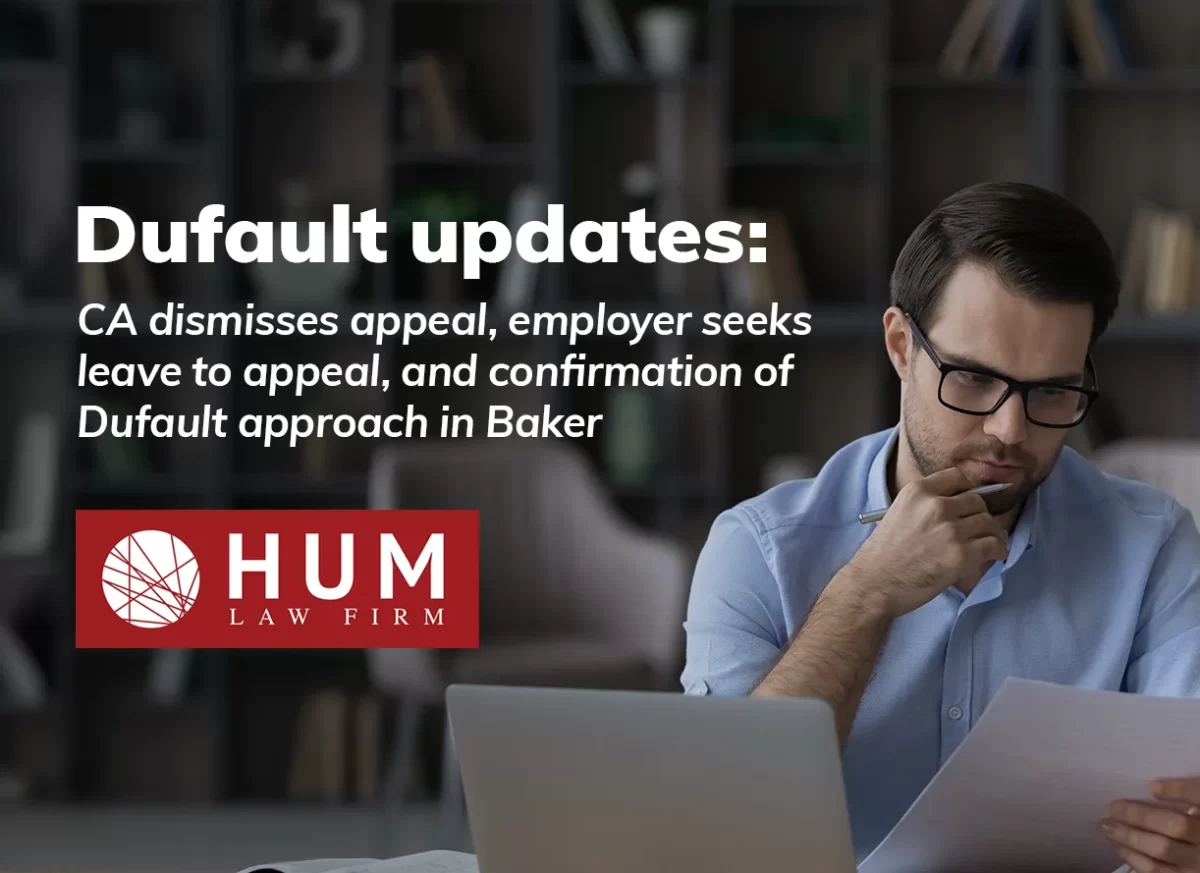We highlighted the decision in the Dufault case when it first came out, one of the most significant from February 2024. There have been a few updates in the last two months. First, in late December 2024, the Court of Appeal dismissed the employer’s appeal, confirming that the “with cause” termination provision was unenforceable on the basis of the Waksdale[1] case, without addressing the original finding on the “without cause” provision. Second, the employer has sought leave to appeal to the Supreme Court of Canada. And finally, a Superior Court judge has confirmed that the finding in Dufault on the “without cause” provision must be applied.
Court of Appeal dismisses appeal of decision in Dufault
On December 19, 2024, ten months after the summary judgment motion decision in the Dufault case, the eagerly awaited Court of Appeal decision was released. As many employment lawyers predicted, the Court of Appeal dismissed the appeal, without addressing the more controversial aspect of the Superior Court of Justice summary judgment decision.
By way of reminder, in Dufault v. The Corporation of the Township of Ignace, 2024 ONSC 1029, an employee, fired without cause two months into a fixed-term contract of over two years, sued for wrongful dismissal claiming the balance of 101 weeks on the fixed-term contract. The employer relied on the termination without cause provision, and provided her with two weeks’ pay, plus continuing benefits for that period. Justice Pierce found that the termination clause was unenforceable as in contravention of the Employment Standards Act, 2000 (ESA), and granted summary judgment as claimed by the employee, finding that:
- The “for cause” provision was in breach of the minimum standards of the ESA, and, based on the approach introduced by Waksdale, if one part of a termination clause is unenforceable, then the entire clause is unenforceable;
- The without cause clause, permitting the employer to have “sole discretion” to terminate the plaintiff’s employment “at any time”, was in breach of the ESA, as the right of the employer to dismiss is not absolute given the prohibition against termination on the conclusion of an employee’s leave (s. 53) or in reprisal for attempting to exercise a right under the ESA (s. 74).
The controversy related to Justice Pierce’s finding that phrases such as “at any time” and “at one’s sole discretion”, both commonly used legalese to indicate the broadest level of employer discretion, rendered the “without cause” provision unenforceable as in breach of employment standards legislation. Some employment lawyers believed that the Superior Court had gone too far, and that this aspect of the decision should be overturned.
The relevant part of the termination “without cause” provision at issue is excerpted below:
4.02 The Township may at its sole discretion and without cause, terminate this Agreement and the Employee’s employment thereunder at any time upon giving to the Employee written notice as follows:
(i) the Township will continue to pay the Employee’s base salary for a period of two (2) weeks per full year of service to a maximum payment of four (4) months or the period required by the Employment Standards Act, 2000 whichever is greater. This payment in lieu of notice will be made from the date of termination, payable in bi-weekly installments on the normal payroll day or on a lump sum basis at the discretion of the Township, subject at all times to the provisions of the Employment Standards Act, 2000.
[….]
The employer in Dufault appealed the decision to the Ontario Court of Appeal. In its ruling, Dufault v. Ignace (Township), 2024 ONCA 915, the appellate court chose to avoid addressing this contentious issue, and confirmed the motion judge’s findings that the termination clause was unenforceable based on its review of the “with cause” termination provision. In short, the court concluded that based on its determination of the “for cause” termination provision, it was no longer necessary to determine submissions relating to the “without cause” termination provision.
Leave to appeal to SCC
Disagreeing with the outcome of the appeal, the Township of Ignace has confirmed filing an application for leave to appeal to the Supreme Court of Canada. The Supreme Court typically only chooses to hear cases that are of public importance and national significance, and only a small percentage of such leave applications are granted. Recent denials include an application for leave to appeal a Court of Appeal decision[2] confirming frustration of contract in the context of mandatory workplace vaccination mandates, as well as the leave to appeal the ground-breaking case of Waksdale.
Since Dufault is primarily a wrongful dismissal case under Ontario employment law, and based on past employment law cases, it is unlikely that the Supreme Court will grant leave to appeal.
Superior Court confirmation of status quo
The Court of Appeal essentially preserved the status quo relating to the most discussed aspect of the Dufault decision, specifically providing in paragraph 25 of its decision:
[25] Given our conclusion that the “for cause” termination clause of the employment contract is unenforceable as contrary to the ESA and that, pursuant to Waksdale, this renders all of the termination provisions unenforceable, it is not necessary to consider the appellant’s arguments that the motion judge erred in finding the “without cause” termination clause also unenforceable as contrary to the ESA, and we expressly do not rule on that submission. The appellant argued that the motion judge’s findings in relation to the “without cause” termination clause may affect other employment contracts. In our view, resolution of the issues the appellant raises regarding the “without cause” termination clause should be left to an appeal where it would directly affect the outcome.
Recently, in Baker v. Van Dolder’s Home Team Inc., 2025 ONSC 952 (“Baker”), an employer brought a motion for summary judgment seeking a finding that the termination clause in the employee respondent’s contract complied with the ESA, and that the employee had been provided with all of her ESA entitlements. Justice Sproat dismissed the summary judgment motion. He concluded that the finding in Dufault was to be applied with respect to the wording of a termination “without cause” provision containing the words “at any time”, rendering it unenforceable. Although not necessary for his decision, Justice Sproat also found that the “with cause” termination provision was also unenforceable
As Justice Sproat stated at the end of his decision, the law has “set an exacting standard that many employers and knowledgeable counsel have failed to attain despite their good faith and best efforts” when it comes to termination clauses and compliance with the ESA.
Conclusion
Dufault and Baker serve as yet further stark reminders to both employers and employees that our courts will closely scrutinize the wording of termination clauses. Any contravention of the minimum requirements of the ESA will render termination clauses unenforceable. Employers are well advised to take heed, seek legal advice, and ensure that their termination clauses are both clear and strictly compliant with the ESA. If they have not already been advised by their employment counsel to do so, they should also consider amending existing contracts, and taking necessary steps before getting existing employees to sign. In the case of Dufault, the difference in liability was dramatic: from 2 weeks notice or pay in lieu if the termination cause was enforceable to 101 weeks if not!
[1] Waksdale v. Swegon North America Inc., 2020 ONCA 391, application for leave to appeal to SCC denied, 2021 CanLII 1109 (SCC).
[2] Croke v. VuPoint System Ltd., 2024 ONCA 354, application for leave to appeal to SCC denied, 2024 CanLII 125008 (SCC).
If you need guidance from an experienced employment lawyer, contact Hum Law today at (416)214-2329 or Complete our Free Assessment Form Here.


